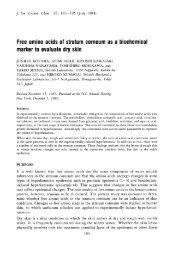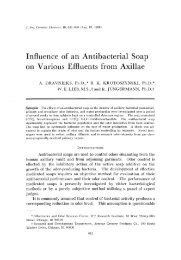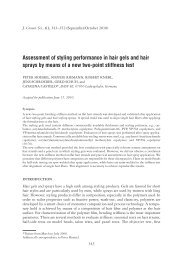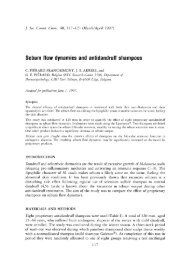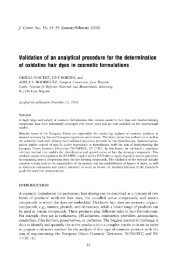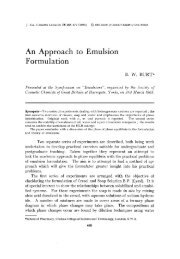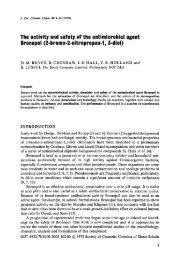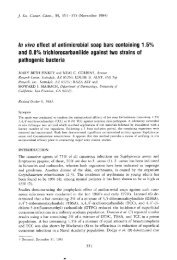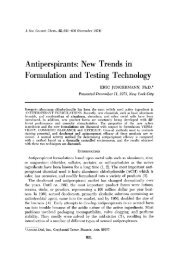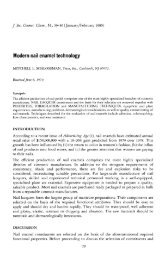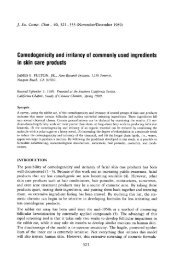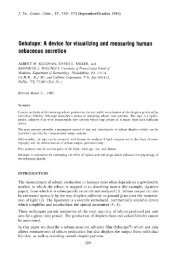A Critical Comparison of Two Procedures for Antiperspirant Evaluation
A Critical Comparison of Two Procedures for Antiperspirant Evaluation
A Critical Comparison of Two Procedures for Antiperspirant Evaluation
Create successful ePaper yourself
Turn your PDF publications into a flip-book with our unique Google optimized e-Paper software.
,<br />
ß<br />
--<br />
268 JOURNAL OF THE SOCIETY OF COSMETIC CHEMISTS<br />
Table IV<br />
Summary <strong>of</strong> Ratios <strong>for</strong> Method B<br />
Subject Number Rp• Rpo. tl•, lit<br />
13 1.012 0.980 0.996 0.417 0.419<br />
14 1.084 1.117 1.101 0.664 0.603<br />
15 1.135 1.089 1.112 0.800 0.719<br />
16 1.359 1.339 1.349 0.517 0.383<br />
17 0.978 0.896 0.937 0.676 0.72I<br />
18 0.600 0.709 0.655 0.517 0.790<br />
19 0.421 0.763 0.592 0.429 0.725<br />
20 0.830 0.757 0.794 0.643 0.810<br />
21 0.837 0.829 0.833 0.567 0.681<br />
22 0.820 0.779 0.800 0.465 0.582<br />
23 1.043 1.154 1.099 0.412 0.375<br />
24 0.746 0.956 0.851 0.510 0.599<br />
The upper and lower confidence limits about the mean per cent reduction<br />
(PR1, PR•,) are computed from these, and the mean per cent reduction PR is<br />
computed from R'<br />
--<br />
UCL <strong>for</strong> R' = 0.7146<br />
mean ratio, R' = 0.6173<br />
LCL <strong>for</strong> R' = 0'.5200<br />
PR1 = (1-0.5200) 100 = 48.00<br />
'•: PR = (1-0.6173)100 = 38.27<br />
PRa = (1-0.7146)100 = 28.54<br />
C. BM Calculations With Trans<strong>for</strong>mation<br />
This method takes into account the fact that correct estimates <strong>of</strong> the mean<br />
ratios and other statistics cannot be obtained by method B because neither the<br />
ratios nor the milligram values from which they are derived are normally distributed.<br />
In addition, despite the adjustment procedure, some sides effects<br />
may remain in the data, and there<strong>for</strong>e the error estimate must be obtained<br />
from the data after accounting <strong>for</strong> these. Since method C also uses adjusted<br />
ratios, however, it cannot compensate <strong>for</strong> any distortion in the per cent reduction<br />
estimates , which may be introduced by the adjustment procedure. There<strong>for</strong>e,<br />
although the method is more nearly Correct than B, it still may not give<br />
correct results. Note also that, quite aside frbm these considerations, the error<br />
estimate yielded by method C has a different composition than that <strong>of</strong> method<br />
A, although it is not necessarily incorrect.<br />
The normality problem is handled by trans<strong>for</strong>ming the ratios to their logarithms<br />
be<strong>for</strong>e manipulating them, then back-trans<strong>for</strong>ming them. Since the



